5G Signalling Procedures Part-2 Updated In 2024
Introduction To 5g Signalling Procedures
As the landscape of 5G technology continues to evolve, understanding the intricate signalling procedures involved in maintaining seamless connectivity becomes crucial. This blog explores some of the advanced 5G signalling procedures as of 2024, with a focus on the interaction between 4G and 5G nodes during the EUTRA-NR Dual Connectivity (EN-DC) process. Specifically, we’ll discuss the handling of Signalling Radio Bearer (SRB) messages, resource coordination between nodes, and additional signalling features like the SGNB Addition Trigger Indication and Subscriber Profile Identity (SPID).
EN DC Secondary Cell Addition In 5G Signalling Procedures
- The EUTRA-NR Dual Connectivity (EN-DC) Secondary Cell Addition procedure is used to provide a UE with an NR Secondary Cell. The UE must already be connected to the 4G Master Node as a prerequisite to this procedure. Figure below illustrates the radio network signalling for the initial 4G connection. It is assumed that the UE haS already completed the Non-Access Stratum (NAS) Attach procedure so the UE is already registered with the 4G Core network.
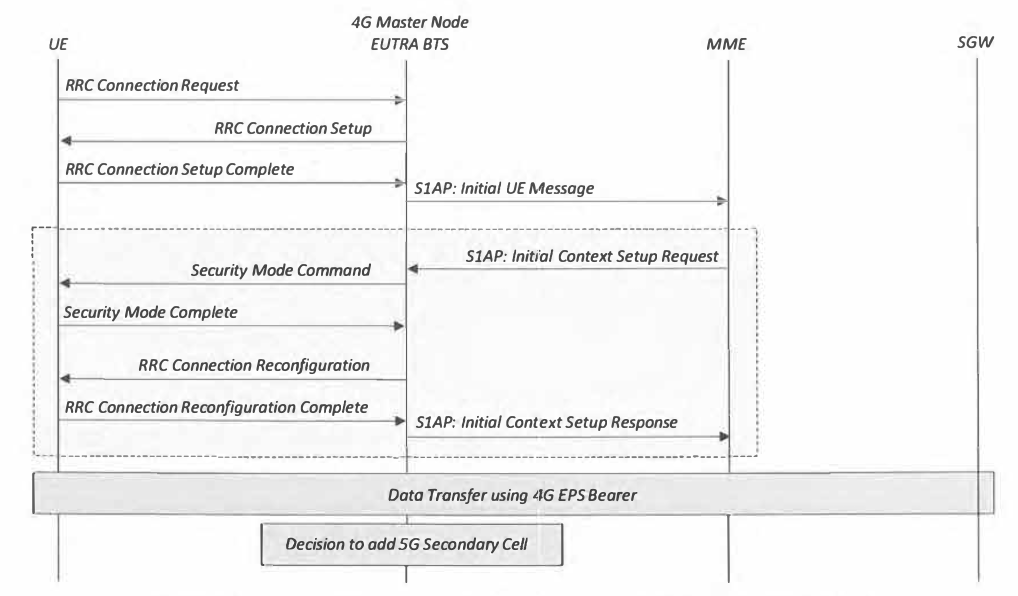
Initial Context Setup and Key Parameters
- From the perspective of the EN-DC Secondary Cell Addition procedure, the most important part of this connection setup is the SI AP: Initial Context Setup Request message (specified by 3GPP TS 36.413). This message includes both UE capability information and UE subscription information. The most relevant content from within this message is presented in Table below.
- The ‘UE Aggregate Maximum Bit Rate’ (UE-AMBR) is part of the UE subscription information. Limits are specified for both the uplink and downlink directions. These must be high enough to support the throughputs provided by the 5G air-interface. The 4G Master Node is responsible for allocating either some or all of the UE-AMBR to the 5G Secondary Node during the Secondary Cell Addition procedure (using the X2AP: SGNB Addition Request presented later in this section).
- The ‘E-RAB to be Setup List’ specifies the set of E-RAB belonging to the set of EPS Bearers which are to be established. This may include a non-Guaranteed Bit Rate (non-GBR) EPS Bearer with QCI = 6, 7, 8 or 9, for data transfer. It may also include a non-GBR EPS Bearer with QCI=5, for signalling to an IMS.
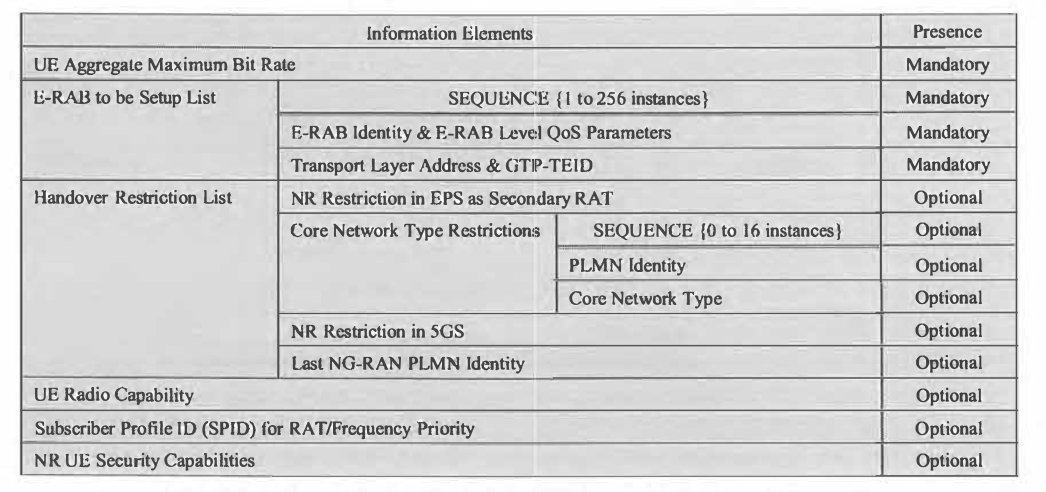
Admission Control and Handover Considerations In 5G Signalling Procedures
E-RAB Level QoS Parameters and Admission Control
- The ‘E-RAB Level QoS Parameters’ within the ‘E-RAB to be Setup List’ includes the subscribed Allocation and Retention Priority (ARP). This could be used as part of the Admission Control decision for Secondary Cell Addition, e.g. only UE with a specific ARP value are considered for Secondary Cell Addition. The use ofARP in this way depends upon the network implementation.
Handover Restriction List and UE’s 5G Subscription
- The ‘Handover Restriction List’ can include the ‘NR Restriction in EPS as Secondary RAT field which can serve as the primary indication of the UE’s 5G subscription. Inclusion of this field with a value of ‘NR restricted in EPS as Secondary RAT indicates that the end-user has not subscribed to 5G services and the EPS Bearers are to be kept on 4G. Exclusion of this field indicates that the end-user has subscribed to 5G services and is not restricted in terms of EN-DC Secondary Cell Addition. The 4G Master Node can use this field when executing its Admission Control decision for Secondary Cell Addition.
- The ‘Handover Restriction List’ can also include the ‘Core Network Type Restrictions· and ‘NR Restriction in 5GS’ fields but these are applicable to deployments which include the 5G Core Network. The: ‘Core Network Type Restrictions’ field can be used to forbid connection to specific 5G Core Networks, whereas the ‘NR Restriction in 5GS’ field can be used to forbid the use of NR when connecting to a 5G System (the UE could use LTE if a Next Generation eNode B is connected to the 5G Core Network).
UE Capabilities and Impact on Admission Control
- The ‘UE Radio Capability’ provides the 4G Master Node with information which has previously been reported by the UE. This information is stored as part of the UE context within the MME to avoid having to re-request it for every RRC Connection setup. The 4G Master Node uses this field to gain knowledge of the UE’s 5G capability which can then impact the Admission Control decision for the EN-DC Secondary Cell Addition in 5G signalling procedures.
- The ‘Subscriber Profile ID’ (SPID} can be allocated as part of the UE’s subscription information. It can be used to identify specific mobility preferences for each UE. Within the context of EN-DC, it is useful when the Secondary Cell Addition procedure is supported from only a subset of the 4G carriers. In this case, the SPlD can be used to identify the requirement to move the UE onto an RF carrier which supports the addition procedure. For example, all UE which have subscribed to 5G services could be allocated an SPID = 100, which could then trigger the 4G Master Node to apply a specific set of mobility management rules to move the UE onto an appropriate RF carrier. The mobility management rules could be applied in RRC Idle mode by assigning a specific set ofAbsolute Priorities, or in RRC Connected mode by triggering inter-frequency handovers.
Secondary Cell Addition Procedures
- The ‘NRUE Security Capabilities’ provides information regarding the integrity protection and encryption algorithms supported by the UE. This information can be used during the subsequent EN-DC Secondary Cell Addition procedure.
- Data transfer can start, using the 4G Master Node and the LTE air-interface once the Data Radio Bearers (DRB) have been setup at the UE using the RRC Connection Reconfiguration procedure. The 4G Master Node is then responsible for triggering the EN-DC Secondary Cell addition. For example, the triggering mechanism could be based upon data volume, i.e. if the UE transfers a small quantity of data then there is less justification to proceed with the additional signalling associated with Secondary Cell addition. If the UE transfers a larger volume of data then Secondary Cell addition is more likely to benefit both the network and the end-user.
- If 4G Master Node will also check its Admission Control criteria before initiating the Secondary Cell addition. The criteria could include: the UE capability, the NR Restriction flag within the Handover Restriction List, the QCI belonging to each EPS Bearer, the allocated ARP, the current 4G RF Carrier and consequently the resultant LTE/NR band combination. The Secondary Cell Addition procedure can be applied to a subset of the allocated EPS Bearers. For example, if the UE is allocated an EPS Bearer with QCI 8 for data transfer, and an EPS Bearer with QCI 5 for SIP signalling, then the Secondary Cell Addition procedure can be applied to the QCI 8 EPS Bearer, while leaving the QCI 5 EPS Bearer to use only the 4G Master Node.
- Secondary Cell Addition can be blind which means that the 4G Master Node adds a default 5G Secondary Cell without relying upon measurements. This approach is less reliable unless the 4G and 5G 1coverage footprints are the same and there is a clear one-to-one mapping between each 4G cell and 5G cell. Blind Secondary Cell Addition can benefit from reduced latency because the UE is not required to complete measurements before the procedure starts.
Synchronization and Measurement Gaps
- Alternatively, Secondary Cell Addition can be based upon inter-system measurements reported by the UE. This approach helps to ensure that there is sufficient NR coverage before initiating the addition procedure, i.e. the success rate of the addition procedure can be improved. However, the measurement procedure introduces additional delay and the Measurement Gaps required for the inter-system measurements disrupt the transfer of data prior to the Secondary Cell Addition.
- The UE capability information does not specify the UE Measurement Gap requirement for individual operating band combinations. Thus, the 4G Base Station always configures Measurement Gaps for NR measurements while connected to 4G. These Measurement Gaps need to be synchronised with the SS/PBCH transmissions which arc to be measured. Figure below illustrates the general timing of the SS/PBCH transmissions within a Measurement Gap.

Measurement Gap Configuration and SS/PBCH Transmission
- A Measurement Gap is configured using the 4G MeasGapConfig parameter structure. This parameter structure specifies the ‘Gap Pattern Identity’ and the ‘Gap Offset’. The set of Measurement Gap Patterns is presented in Table below. Measurement Gap Lengths (MGL) of 3, 4 or 6 ms can be configured. The duration of the Measurement Gap must be longer than the duration of the SS/PBCH transmissions to accommodate the delays generated by transceiver re-tuning, i.e. re-tuning to the NR carrier before starting the measurements and subsequently re-tuning back to the 40 carrier after completing the measurements. Each re-tuning delay is assumed to be 0.5 ms when measuring a carrier within Frequency Range 1, and 0.25 ms when measuring a carrier within Frequency Range 2. This means that a 3 ms Measurement Gap allows 2 ms for measurements when measuring an RF carrier within Frequency Range 1.

SS/PBCH Transmission and its Impact on Measurement Gaps
- The duration of the SS/PBCH transmissions depends upon the subcarrier spacing (which determines the slot duration) and the number of SS/PBCH Blocks within each burst. Table below specifics the duration of the SS/PBCH transmissions for each subcarrier spacing when assuming the maximum permitted number ofSS/PBCH Blocks within each frequency range In 5G Signalling Procedures

Configuring the SS/PBCH Measurement Timing
- Equal to the SS/PBCH transmission period, or a multiple of the SS/PBCH transmission period. Longer MGRP values reduce the impact upon 4G data transfer while the UE completes its measurements but can increase the overall duration of the measurements.
- ‘Gap Offset’ has a step size of 1 ms and defines the start of the Measurement Gaps relative to the start of the radio frame with System Frame Number (SFN) equal to 0. The expressions shown below are used to calculate the radio frame and subframe for the start of each Measurement Gap. These expressions arc based upon the radio frame and subframe numbering belonging to the 4G system.
- The UE is also provided with information regarding the timing of the SS/PBCH transmissions within the Measurement Gap. This information is provided in terms of an SS/PBCH Block Measurement Timing Configuration (SMTC). The SMTC defines a period, an offset and a duration, i.e. it uses a similar format to the Measurement Gap configuration. The SMTC is configured as part of the NR Measurement Object within an RRC Connection Reconfiguration message. The content of an NR Measurement Object is presented in Table below (the measTimingConfig-r15 field corresponds to the SMTC).
- The SMTC duration can be configured with a value of 1, 2, 3, 4 or 5 subframes (equivalent to 1, 2, 3, 4, or S ms). The duration should be large enough to capture all SS/PBCH transmissions. The figures presented in Table above can be used when the maximum number of SS/PBCH transmissions are active. Otherwise, the appropriate duration can be determined by identifying the range of symbols occupied by the set SS/PBCH. The candidate starting symbols for the set ofSS/PBCH transmissions are presented in Table 56 (section 3.4). For example, if 1 SS/PBCH transmission is active while using the 30 kHz subcarrier spacing then the single transmission is accommodated within a single 0.5 ms slot and the SMTC duration can be set to 1 ms. Alternatively, if the first 32 SS/PBCH transmissions are active while using the 240 kHz subcarrier spacing then the transmissions span 16 slots (symbols 8 to 215). Each slot has a duration of 0.0625 ms so this requires an SMTC duration of 1 ms.
- The ‘SMTC Offset’ has a step size ofI ms and defines the start of the SS/PBCH measurement window relative to the start of the radio frame with System Frame Number (SFN) equal to 0. The expressions shown below arc used to calculate the radio frame and subframe for the start of each SS/PBCH measurement window. Similar to the Measurement Gap calculations, these expressions arc based upon the radio frame and subframe numbering belonging to the 40 system
- In many cases, the 4G and 5G radio frames will be aligned and the SS/PBCH transmissions will start at the beginning of a 4G/5G radio frame. In these cases, the ‘SMTC Offset’ can be set to 0ms. In some cases, a time offset may be introduced between the 4G and 5G radio frame timing. For example, a scenario which involves delaying the 5G radio frames by 3 ms. In this example, the ‘SMTC Offset’ can be set to 3 ms.
SFN mod T= FLOOR (Offset/10), T = CELL(Periodicity/10)
subframe = Offset mod 10, ifPeriodicity> 5 subframes
subframe = Offset or Offset+ 5, ifPeriodicity< 5 subframes
- 3GPP identified an issue with the 1ms step size for the Measurement Gap and SMTC Offsets. In some cases, it leads to an overlap between the transceiver re-tuning period and the SS/PBCH Measurement Window. Figure below illustrates an example of a 6 ms Measurement Gap and a 5 ms SS/PBCH Measurement Window. The Measurement Gap and the SS/PBCH Measurement Window are assumed to have equal offsets so they both start at the same time. This means that the start of the SS/PBCH Measurement Window is lost due to the transceiver re-tuning delay. The Measurement Gap Offset could be reduced by 1 ms but this would cause the end of the SS/PBCH Measurement Window to be lost.
Addressing Timing Conflicts
- 3GPP resolved this issue by introducing the use of a Measurement Gap Timing Advance (MOTA) which can be enabled using the mgta information element within the 4G MeasConfig parameter structure. The timing of the Measurement Gap is advanced by 0.5 ms when MGTA is enabled. This provides support for configurations which require the Measurement Gap to extend 0.5 ms either side ofthe SS/PBCH Measurement Window.

- The MeasObjectNR starts by specifying the frequency of the NR carrier to be measured. This corresponds to the center frequency of the SS/PBCH rather than the center frequency of the channel bandwidth. The center frequency of the SS/PBCH is expressed in terms of an NR-ARFCN rather than a Global Synchronisation Channel Number (GSCN). This caters for SS/PBCH which may not be positioned on the GSCN frequency raster. SS/PBCH which are used for initial access from RRC Idle must be on the GSCN frequency raster because the UE only checks those frequencies when completing a band scan. However, SS/PBCH which arc not used for initial access arc not restricted to the GSCN frequency raster. These SS/PBCH can be positioned at any NR-ARFCN (while ensuring that subcarrier alignment is maintained between the SS/PBCH and the channel bandwidth).
- The SMTC information is followed by a specification of the SS/PBCH subcarrier spacing. Values of 15 and 30kHz are applicable to Frequency Range 1, whereas values of 120 and 240 kHz are applicable to Frequency Range 2. The 60 kHz subcarrier spacing is not applicable to the SS/PBCH. A bitmap is then used to specify which SS/PBCH Blocks are available for measurement. The bitmap has a length of4 bits for operating bands <=3 GHz because a maximum of 4 SS/PBCH Blocks can be configured for transmission. Similarly, the bitmap has a length of8 bits for operating bands > 3 GHz but <=6 GHz, and a length of 64 bits for operating bands > 6 GHz
- Measurement based Secondary Cell Addition is likely to rely upon Reporting Event BI which is triggered when an inter-system measurement exceeds a specific threshold. The measurement used to trigger Event BI is a ‘cell level’ measurement rather than a ‘beam level’ measurement. (if a cell is configured with multiple SS/PBCH beams then it is necessary to derive the ‘cell level’ measurement from one or more ‘beam level’ measurements. The UE derives the ‘cell level’ measurement using the threshRS-lndex and maxRS lndexCellQual information elements.
- If maxRS-indexCellQual is not included within the Measurement Object, the UE sets the ‘cell level’ measurement equal to the highest ‘beam level’ measurement. Otherwise, the UE derives the ‘cell level’ measurement by calculating a linear average of the highest ‘beam level’ measurements which exceed threshRS-index. The maximum number of ‘beam level’ measurements included in the average is defined by maxRS-lndexCellQual. If none of the beam level measurements exceed threshRS-lndex, the ‘cell level’ measurement is set equal to the highest ‘beam level’ measurement.
- offsetFreq defines a measurement offset which is applied to the ‘cell level’ measurement when evaluating the Reporting Event criteria. A negative value makes it more difficult to trigger Event B1 because the measurement result is decreased by the offset.
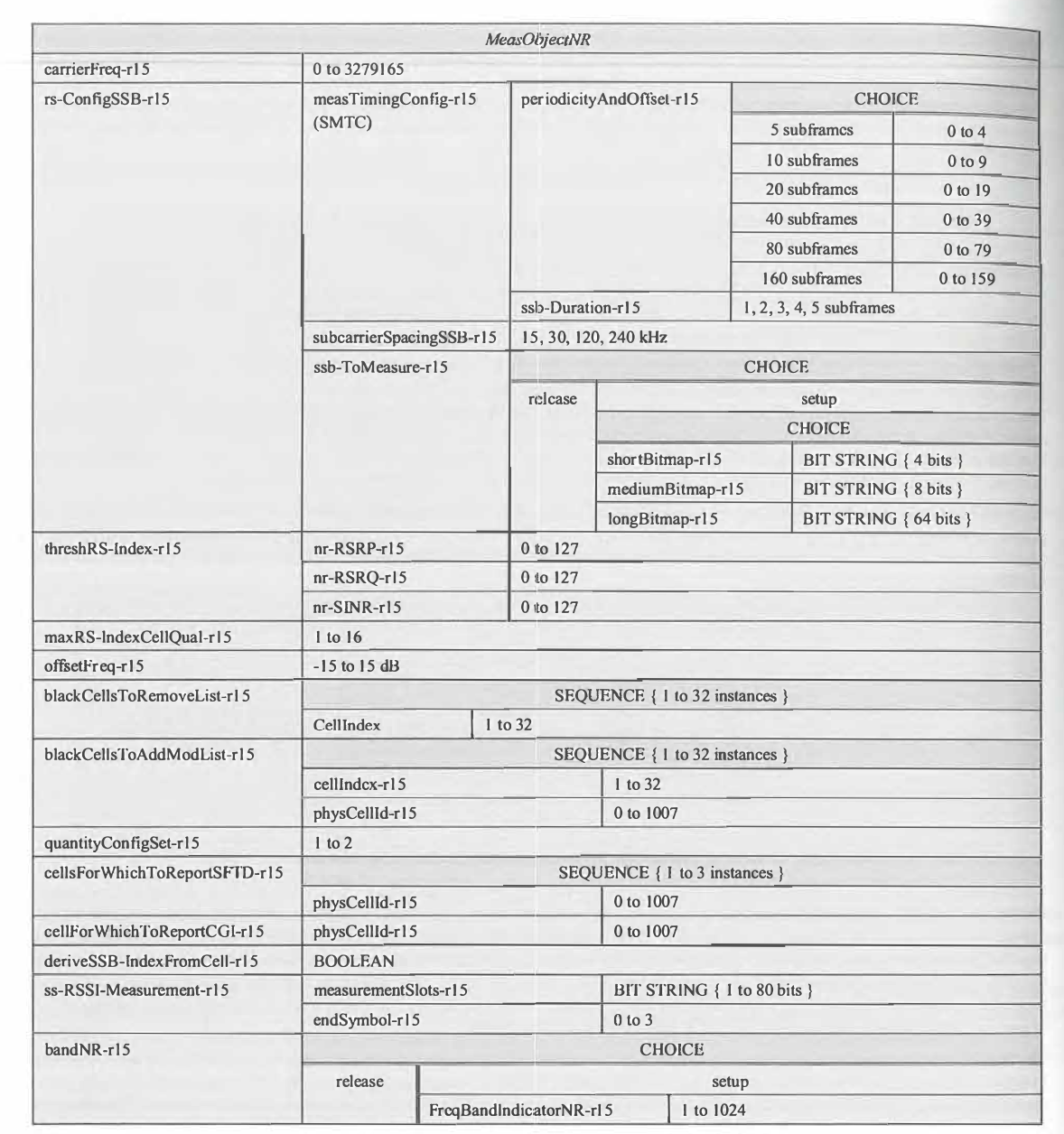
Measurement Reporting Event BI
- bandNR-r15 specifics the operating band associated with the SS/PBCH measurements. This provides clarification of the operating band when operating bands overlap and share common NR-ARFCN values.
- Assuming that the UE has been configured with Measurement Reporting Event BI, the UE will forward an RRC Measurement Report to the Base Station if the measurements exceed the Event BI triggering threshold. This Measurement Report will include the measResultneighCel/ListNR parameter structure shown in Table below. The UE uses this parameter structure to report measurements from up to 8 NR cells which have satisfied the Event BI triggering criteria. Each cell is identified by its PCI.
- The measResultCell field is used to report ‘cell level’ measurements in terms of RSRP, RSRQ and/or SINR. At this stage, the Base Station has already specified the requirement for each of these reporting quantities within the RRC Connection RecorifigUration message that was used to configure the measurements, i.e. using reportQuantityCellNR within ReportCorifiglnterRAT.
- The measResultRSlndexlist field is used to report ‘beam level’ measurements in terms of RSRP, RSRQ and/or SINR. The Base Station can enable/disable the inclusion of ‘beam level’ measurements using the reportRS-/ndexResultsNR flag within ReportConflglnterRAT. When ‘beam level’ measurements are to be included, the Base Station specifics the reporting quantities using reportQuantityRSIndexNR. Each beam is identified by its SS/PBCH Block index. ‘Beam level’ results are useful because they allow the target 5G Secondary Node to allocate dedicated PRACH preambles belonging to the reported beams. The UE can then use one of those dedicated PRACH preambles during the Secondary Cell Addition procedure, i.e. to avoid using the Contention based Random Access procedure.
- The cgi-lnfo field is applicable to Automatic Neighbour Relations (ANR) rather than Secondary Cell Addition. This field allows the UE to report a Cell Global Identity (CGI) for a candidate neighbouring cell. The 4G Base Station can use this information to request the transport layer address belonging to the neighbouring 5G Base Station and subsequently initiate an X2 Setup procedure. The UE extracts the CGI from STBI so the ANR procedure relies upon the 5G cell broadcasting SIBI. In the case ofthe Non-Standalone Base Station architecture, the 5G cell may not broadcast any SIB meaning that the normal ANR procedure is not possible. The UE can use the noS/8I field to provide additional information when the SS/PBClI being measured docs not have an associated SIBI transmission.
Handling SS/PBCH Transmissions and SIB1
- 5G cell can have multiple SS/PBCH transmissions distributed across the channel bandwidth. Some of these SS/PBCH may have an associated SIB 1, whereas other SS/PBCH may not have an associated SIB 1. If the UE is requested to report the CGI using an NR ARFCN which corresponds to an SS/PBCH which does not have an associated SIB1, then the UE can report the ssb-SubcarrierOffset and pdcch-ConflgSIB I fields from the PBCH. These fields can be used lo provide information regarding the frequency domain position of an SS/PBCH which has an associated SIBI transmission. The 4G Base Station could then request the UE to repeat the CGI decoding attempt using a different NR-ARFCN.
RRC Connection Reconfiguration and Measurement Reporting
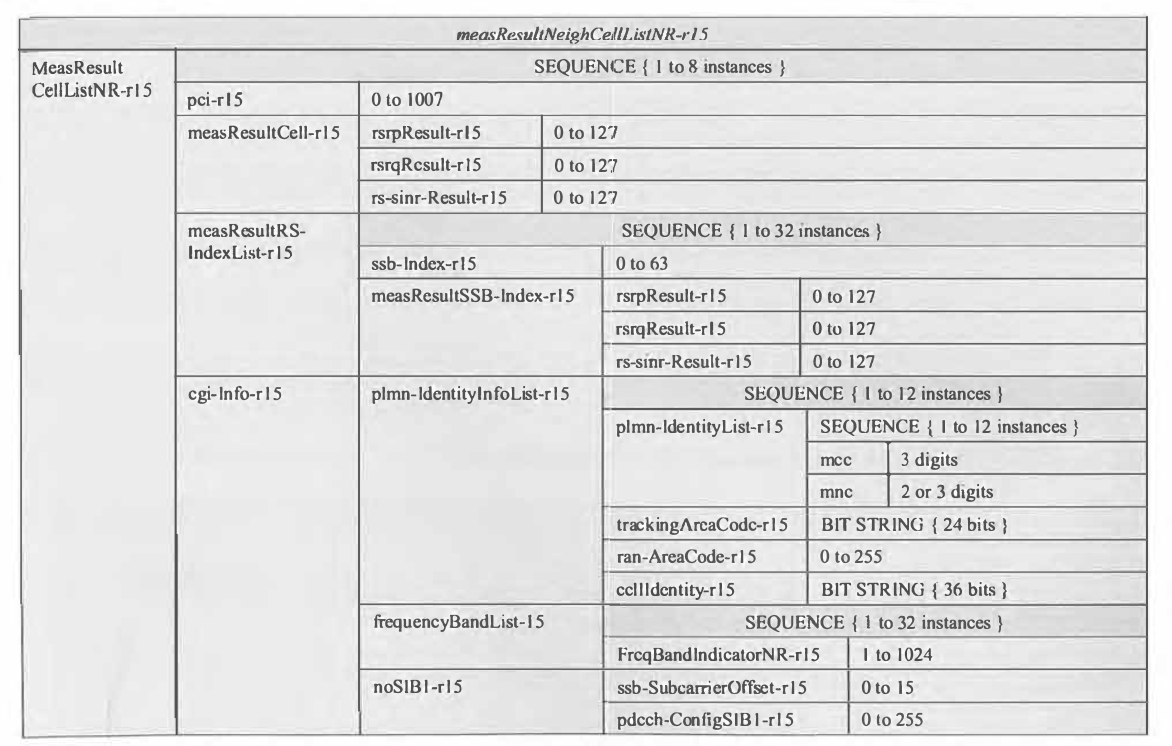
- The top part of Figure below illustrates the RRC Connection Reconfiguration procedure used to configure the Event BI measurements. The figure also shows the Measurement Report generated by the UE. The 4G Master Node starts the actual EN-DC Secondary Cell Addition procedure once the Measurement Report has been received (assuming the report has been triggered by a 5G cell which has an X2 connection with the 4G Master Node). The report will typically be triggered by a co-sited 5G cell.
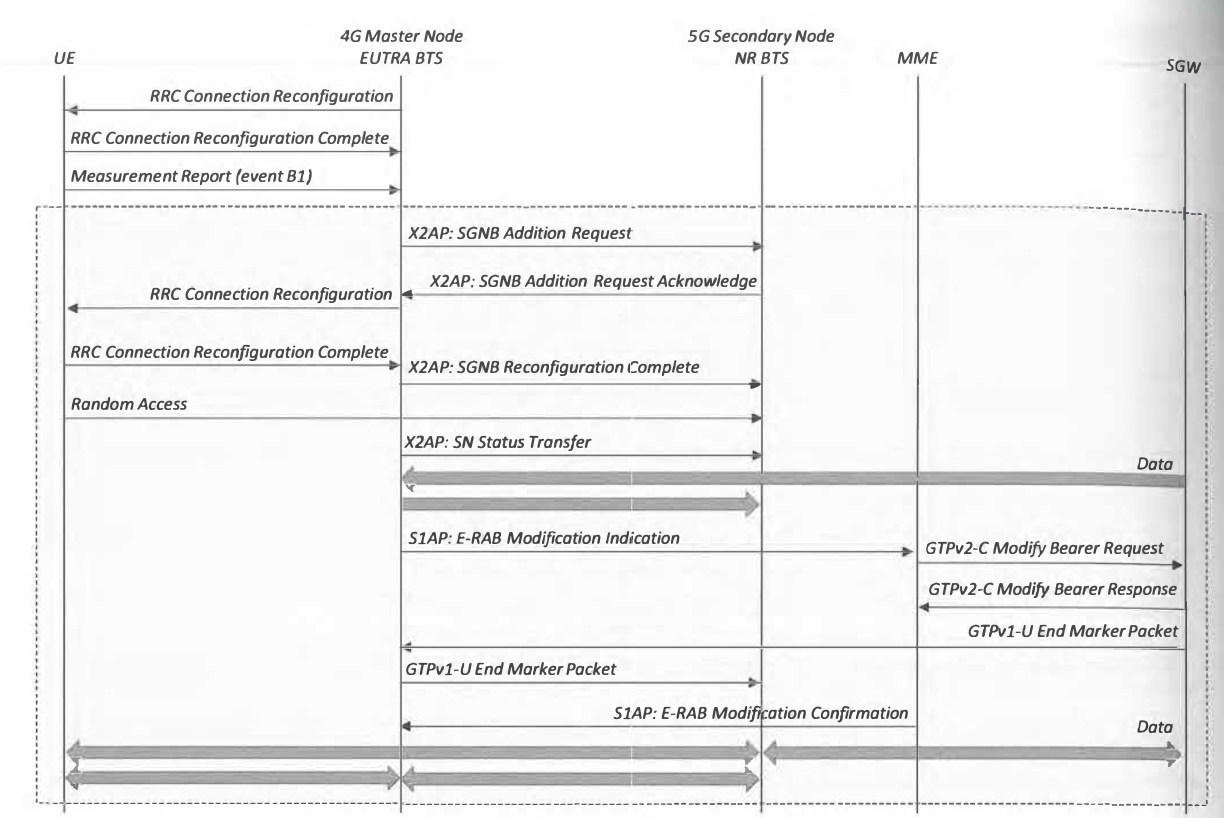
X2AP: SGNB Addition Request
- The content of the X2AP: SGNB Addition Request is presented in Table below. The 4G Master Node allocates the ‘MeNBUEX2AP Identity’ to allow the Master Node to identify the UE within X2AP signalling procedures. The ‘NR UE Security Capabilities’ provides the 5G Secondary Node with information regarding the ciphering and integrity protection algorithms supported by the UE. This information is extracted from the SI AP: Initial Context Setup Request provided by the MME. The ‘SgNB Security Key’ is used to derive the keys for the ciphering and integrity protection algorithms at the 5G Secondary Node.
- The ‘SgNB UE Aggregate Maximum Bit Rate’ is based upon the ‘UE Aggregate Maximum Bit Rate’ provided by the MME within the SI AP: Initial Context Setup Request. The 4G Master Node is responsible for managing the allocated values across the Master and Secondary Nodes. The ‘Selected PLMN’ can be used to specify the identity of the PLMN to be used at the Secondary Node. The ‘Handover Restriction List’ is based upon the corresponding field within the Sl AP: Initial Context Setup Request.
- The ‘E-RAB to be Added List’ is a relatively large field which provides the information necessary for the 50 Secondary Node to setup each E-RAB and the associated Data Radio Bearers (DRB). This field provides the 5G Secondary Node with the Serving Gateway (SGW) transport layer address and GTP Tunnel Endpoint Identity (TEID) for transferring uplink data across the S1-U interface. It also provides the 5G Secondary Node with the 4G Master Node transport layer address and GTP TEID for transferring downlink data across the X2-U interface.
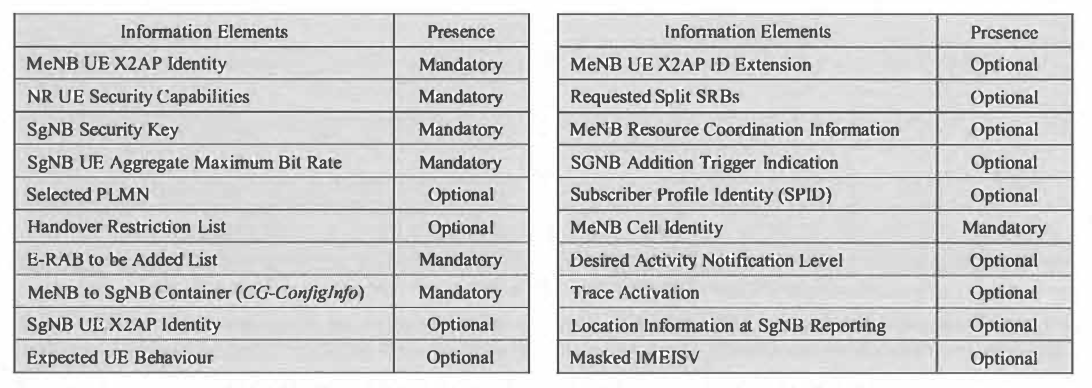
Response: X2AP: SGNB Addition Request Acknowledge
- The ‘McNB to SgNB Container’ is used to encapsulate the CG-Config lnfo message belonging to the 5G RRC signalling protocol. This message provides the 5G Secondary Node with the UE capability. It also specifies one or more candidate 5G cells to be targeted by the EN-DC Secondary Cell addition. Measurements can be included if they have been received from the UE. Permitted EN-DC band combinations can also be specified with feature sets listed for each combination.
- The ‘SgNB UE X2AP Identity’ is allocated by the 5G Secondary Node but it can be included within the X2AP:SGNB Addition Request it if has already been allocated during a previous signalling procedure.
- The ‘Expected UE Behaviour’ can be used to provide information regarding the expected UE activity and mobility. This information can be used to help determine an optimal RRC Connection duration. The expected activity information can include an expected activity period and an expected idle period. This information can originate from previous measurements, or it can be based upon subscription information. The expected mobility is specified in terms of an expected handover interval.
- The ‘MeNB UE X2AP JD Extension’ can be used to increase the range of values associated with the ‘McNB UE X2AP Identity’. This may be necessary if there is a requirement to support a large number of UE associated signalling connections across the X2 interface. Each information element supports a range from 0 to 4095. The extension is used in combination with the original identity so the range increases from {0 to 4095} to {0 to 16 777 2I6}.
- The ‘Requested Split SRBs’ field is used to specify that SRB1 and SRB2 are to be split between the 4G Master Node and 5G.
- Secondary Node, i.e. SRB messages from the 4G Master Node will be forwarded across the X2 interface to the 5G Secondary Node. It is possible to specify that SRB 1 will be split, or SRB 2 will be split, or both SRB 1 and SRB 2 will be split
- The ‘McNB Resource Coordination Information’ can be used to support the coordination of air-interface resources between the 4G Master Node and 5G Secondary Node. This is applicable to Dynamic Spectrum Sharing scenarios. The 4G Master Node uses a bitmap to specify which Resource Blocks within specific subframes it would like to use.
- The ‘SGNB Addition Trigger Indication’ can be used to indicate the reason for the Secondary Cell Addition procedure. The reason can be specified as ‘Secondary Node Change·, ‘inter-cNode B Handover’ or ‘intra-eNode B Handover’.
- The ‘Subscriber Profile Identity (SPID)’ provided by the MME can also be forwarded to the 5G Secondary Node. This may be used to influence mobility procedures at the Secondary Node.
- The ‘Desired Activation Notification Level’ can be used to request the 5G Secondary Node to forward X2AP: SGNB Activity Notification messages providing either ‘UE level’ information or ‘E-RAB level’ information.
- The ‘McNB Cell Identity’ specifies the identity of the primary serving cell within the 4G Master Node.
- ‘Trace Activation’ can be used to enable logging at the 5G Secondary Node. The ‘Trace Activation’ field can specify the interfaces to be logged. These include the X2, Uu, F 1-C and EI interfaces.
- The ‘Location Information at SgNB Reporting’ field can be used to request the 5G Secondary Node to report the UE location.TheUE location can be reported in terms of its cell identity and an update can be provided when the UE changes serving cell.
- The ‘Masked IMEISV’ can be used to identify a UE model, without identifying the individual UE.The MME can provide this information to the 4G Master Node within the SIAP: Initial Context Setup Request. The 5G Secondary Node can use this information if there is a requirement to apply specific rules to some UE models. The ‘Masked IMEISY’ has the last 4 digits of the Serial Number (SNR) set to 1 to avoid exposing the full UE identity.
- Returning to Figure above, the 5G Secondary Node responds with an X2AP:SGNB Addition Request Acknowledge. The content of this message is presented in Table below. The 5G Secondary Node provides a list of the E-RAB which have been admitted. This field specifics the transport layer address and GTP Tunnel Endpoint Identity (TEID) for transferring downlink data across the S1-U interface towards the 5G Secondary Node. It also specifics the 5G Secondary Node transport layer address and GTP TEID for transferring uplink data across the X2-U interface, i.e. to allow the 4G Master Node to forward uplink data so it can be sent to the S-GW.
- The 5G Secondary Node can also list any E-RAB which have not been admitted. In this case, the E-RAB identity is specified in combination with a cause value.

- The 4G Master Node sends an RRC Connection Reconfiguration message to the UE which encapsulates both the 5G RRCReconfiguration message and the 5G RadioBearerConfig parameter structure. Figure below illustrates the encapsulation of this 5G content within the X2AP and 4G RRC messages.
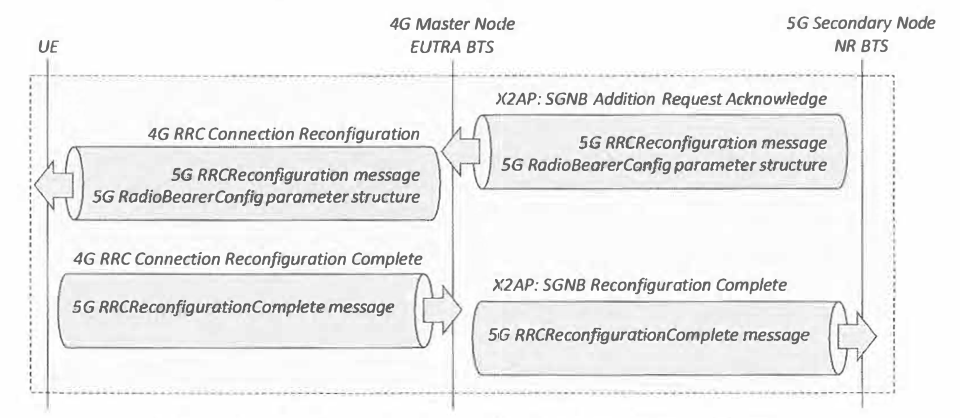
UE Response: RRC Connection Reconfiguration Complete
- The UE responds to the 4G Master Node with a 4G RRC Connection Reconfiguration Complete message, which encapsulates a 5G RRC Reconfiguration Complete message. This pair of messages allows the reconfiguration procedure to be acknowledged at both the 4G.
- Master Node and the 5G Secondary Node. The 5G message is forwarded towards the 5G Master Node using the X2AP: SGNG Reconfiguration Complete.
- The UE can then proceed to complete the Random Access procedure with the target 5G cell.
- In parallel, the 4G Master Node onwards the X2AP: SN Status Transfer message to the 5G Secondary Node. The content of this message is presented in Table below. It is used to provide the 5G Secondary Node with information regarding the Sequence Number status at the PDCP layer. The ‘UL COUNT’ value specifies the Sequence Number of the first missing uplink SDU, whereas the ‘DL COUNT’ value specifies the next Sequence Number to be allocated to a downlink SDU. The ‘Receive Status ofUL PDCP SDU’ can be used to provide a bitmap where each ‘0’ corresponds to a missing PDCP SDU and the bit position corresponds to a Sequence Number which follows the first missing uplink SDU.
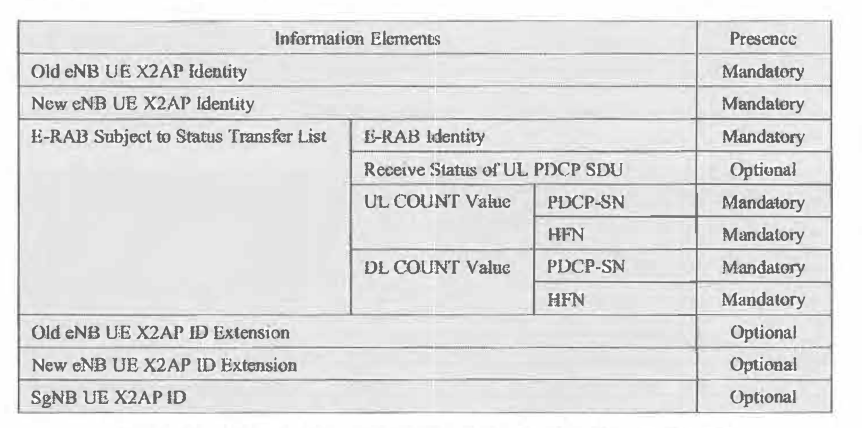
- At this point, the 4G Master Node is still receiving downlink data from the Serving Gateway but this data is now forwarded across the X2 interface towards the 5G Master Node. The 5G Master Node is then able to use the NR air-interface to transfer the downlink data towards the UE.
- The 4G Master Node then initiates the signalling which is used to move the S1-U connection from the 4G Master Node to the 5G Secondary Node. This is done by sending an SI AP: E-RAB Modification indication to the MME. The content of this message is presented in Table 335. The ‘E-RAB to be Modified List’ provides the Transport Layer Address and Downlink GTP TEID provided by the 5G Secondary Node within the X2AP: SGNB Addition Request Acknowledge.
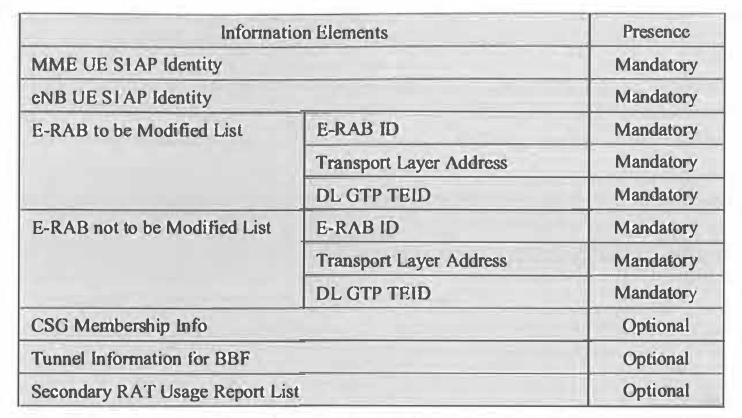
- The MME forwards the new downlink Transport Layer Address and GTPTE ID to the Serving Gateway using a GTPv2-C: Modify Bearer Request. The Serving Gateway acknowledges the request using a GTPv2-C: Modify Bearer Response. These GTPv2-C messages are specified within 3GPP TS 29.274
- The Serving Gateway sends a GTPv1-U: End Marker packet to the 4G Master Node after stopping the downlink packet flow towards the 4G Master Node. This packet is then forwarded across the X2 interface towards the 5G Secondary Node. The End Marker packet identifies the point at which the packet flow is switched across to the new S1-U connection towards the 5G Secondary Node. This information is used to support the re-ordering process at the 5G Secondary Node. The End Marker packet is specified within 3GPP TS 29.281.
- The Serving Gateway subsequently forwards all downlink data towards the 5G Secondary Node. The PDCP layer within the 5G Secondary Node can forward the downlink data for transmission across the 5G air-interface. Alternatively, the PDCP layer can forward the downlink data across the X2 interface towards the 4G Master Node. In that case, the 4G Master Node becomes responsible for delivering the downlink data using the 4G air-interface. The algorithm used to select the downlink data path is dependent upon the network implementation. It may be driven by downlink coverage conditions, i.e. data is transferred across the 4G air-interface when the 5G coverage becomes relatively poor. Alternatively, it may be driven by downlink buffer occupancy, i.e. data is transferred across the 4G air-interface if the 5G Secondary Node transmit buffers become relatively full. This could be caused by downlink coverage conditions or air-interface congestion.
- Assuming that the UE is configured with uplink RLC entities for both the 4G Master Node and the 5G Secondary Node, the lJE can be configured with the ul-DataSplit Threshold presented in Table below. This information element belongs to the PDCP-Conflg parameter structure, i.e. the PDCP layer within the UE is responsible for splitting uplink data between the two paths. A default value of ‘infinity’ is assumed if the ul DataSplitThreshold is excluded. The value of ‘infinity’ means that only the primary RLC entity is used for transmission so the uplink data is not split. The primary RLC entity is identified by the primaryPath information element which points towards a specific cell group. Otherwise, the UE is permitted to split the stream of uplink packets between the primary and secondary RLC entities when the total PDCP and RLC data volume pending initial transmission exceeds the value of ul-Data Split Threshold.
Conclusion
The EN-DC Secondary Cell Addition procedure is a sophisticated and essential component of modern 5G networks, enabling seamless transitions between 4G and 5G environments. The updated 5G Signalling Procedures for 2024 highlight the importance of accurate measurement configurations, robust Admission Control criteria, and the careful handling of handover restrictions. As 5G technology continues to evolve, these 5G signalling procedures will play a vital role in delivering high-speed, reliable connectivity to users worldwide.
References
- 4G 5G Testing and protocol analysis
- Syllabus for 4G 5G Protocol Testing Training
- Contact Us for training
- Qualcomm Academy Videos
- 3GPP Website
- ShareTechNotes




Comments
Post a Comment